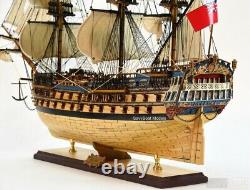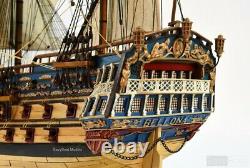
- Home
- Age Level
- Item Length
- Material
- Metal (6)
- Metal, Paper, Wood (12)
- Metal, Plastic, Wood (84)
- Metal, Resin, Wood (5)
- Metal, Wood (70)
- Plastic (14)
- Plastic And Wood (4)
- Plastic, Wood (12)
- Resin, Wood (5)
- Solid Wood (30)
- Wood (2213)
- Wood & Metal (9)
- Wood & Metal Fitting (14)
- Wood And Acrylic (3)
- Wood And Metal (16)
- Wood And Plexiglas (5)
- Wood, Metal (12)
- Wood, Metal Parts (4)
- Wood, Plastic (3)
- Wooden (8)
- Other (1623)
- Scale
- Set Includes
- Armor, Battleship (7)
- Battleship (16)
- Boat (511)
- Boat, Plan, Ship (6)
- Boat, Sailboat, Ship (6)
- Boat, Ship (66)
- Boat, Yacht (10)
- Diorama (5)
- Pirate Ship (8)
- Plan (4)
- Sailbboat Model (3)
- Sailboat (41)
- Sailboat Model (4)
- Ship (125)
- Shipway (8)
- Speedboat (33)
- Steam Boat (19)
- Submarine (5)
- Yacht (48)
- Yacht, Ship (4)
- Other (3223)
- Unit Of Sale
HMS Bellona Tall Sailing Ship Model 42 Handcrafted Wooden Ship Model Royal Navy


















Ready to display and not from any sort of kit. Second photo has apple for scale.
HMS Bellona was one of two Boadicea-class scout cruisers built for the Royal Navy in the first decade of the 20th century. Bellona spent the bulk of World War I with that squadron.
She was present at, but did not fight in, the Battle of Jutland in mid-1916. Her 25-knot (46 km/h; 29 mph) speed was barely capable of matching the speeds of the River-class destroyers she led in her flotilla in 1909 and proved inadequate to match the speed of later destroyers. She was powered by two sets of Parsons steam turbines, each driving two shafts. The turbines produced a total of 18,000 indicated horsepower (13,000 kW), using steam produced by 12 Yarrow boilers that burned both fuel oil and coal, and gave a maximum speed of 25 knots (46 km/h; 29 mph). She carried a maximum of 780 long tons (790 t) of coal and 189 long tons (192 t) of fuel oil.
Her crew consisted of 317 officers and enlisted men. Her main armament consisted of six breech-loading four-inch (102 mm) Mk VII guns. The forward pair of guns were mounted side by side on a platform on the forecastle, the middle pair were amidships, one on each broadside, and the two remaining guns were on the centreline of the quarterdeck, one ahead of the other. The guns fired their 31-pound (14 kg) shells to a range of about 11,400 yards (10,400 m). Her secondary armament consisted of four quick-firing three-pounder 1.9 inches (47 mm) Vickers Mk I guns and two submerged 21-inch (533 mm) torpedo tubes.
During the war, four additional four-inch guns were added amidships to increase her firepower. A QF three-inch (76 mm) 20-cwt anti-aircraft gun was also added. In 1918 it was replaced by a four-inch gun.She had a curved protective deck that was 1 inch (25 mm) thick on the slope and 0.5 inches (13 mm) on the flat. Her conning tower was protected by four inches of armour.

